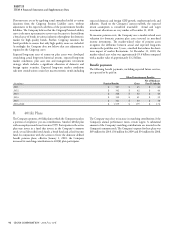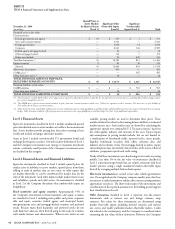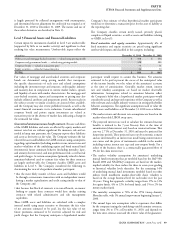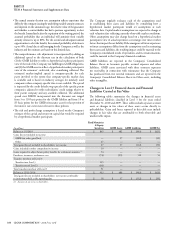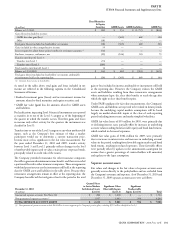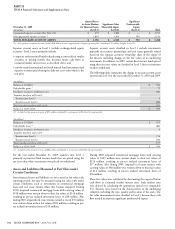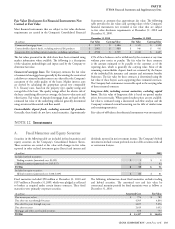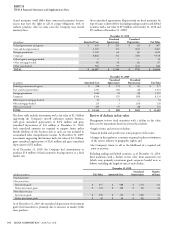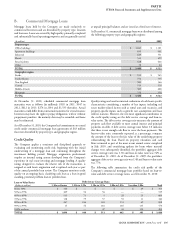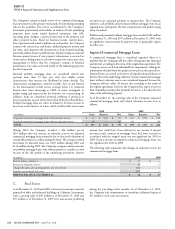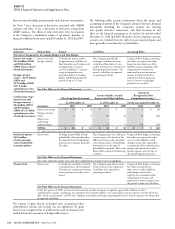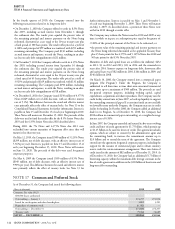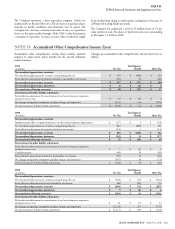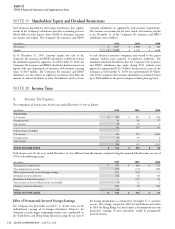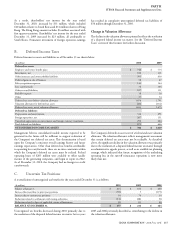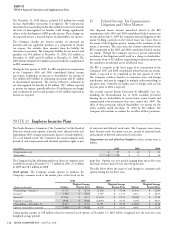Cigna 2010 Annual Report Download - page 126
Download and view the complete annual report
Please find page 126 of the 2010 Cigna annual report below. You can navigate through the pages in the report by either clicking on the pages listed below, or by using the keyword search tool below to find specific information within the annual report.
CIGNA CORPORATION 2010 Form 10K
106
PART II
ITEM 8 Financial Statements and Supplementary Data
e Company’s annual in-depth review of its commercial mortgage
loan investments is the primary mechanism for identifying emerging
risks in the portfolio. is review is performed by the Company’s
investment professionals and includes an analysis of each underlying
property’s most recent annual fi nancial statements, rent rolls,
operating plans, budgets, a physical inspection of the property and
other pertinent factors. Based on historical results, current leases,
lease expirations and rental conditions in each market, the Company
estimates the current year and future stabilized property income and
fair value, and categorizes the investments as loans in good standing,
potential problem loans or problem loans. Quality ratings are adjusted
between annual reviews if new property information is received or
events such as delinquency or a borrower request for restructure cause
management to believe that the Company’s estimate of fi nancial
performance, fair value or the risk profi le of the underlying property
has been impacted.
Potential problem mortgage loans are considered current (no
payment more than 59 days past due), but exhibit certain
characteristics that increase the likelihood of future default. e
characteristics management considers include, but are not limited
to, the deterioration of debt service coverage below 1.0, estimated
loan-to-value ratios increasing to 100% or more, downgrade in
quality rating and request from the borrower for restructuring. In
addition, loans are considered potential problems if principal or
interest payments are past due by more than 30 but less than 60 days.
Problem mortgage loans are either in default by 60 days or more or
have been restructured as to terms, which could include concessions
on interest rate, principal payment or maturity date. e Company
monitors each problem and potential problem mortgage loan on an
ongoing basis, and updates the loan categorization and quality rating
when warranted.
Problem and potential problem mortgage loans totaled $383 million
at December 31, 2010 and $397 million at December 31, 2009, with
no signifi cant concentrations by property type or geographic region
in either year.
Impaired Commercial Mortgage Loans
A commercial mortgage loan is considered impaired when it is
probable that the Company will not collect all amounts due (principal
and interest) according to the terms of the original loan agreement. e
Company assesses each loan individually for impairment, utilizing the
information obtained from the quality review process discussed above.
Impaired loans are carried at the lower of unpaid principal balance or
the fair value of the underlying collateral. Certain commercial mortgage
loans without valuation reserves are considered impaired because the
Company will not collect all interest due according to the terms of
the original agreements; however, the Company does expect to recover
their remaining carrying value primarily because it is less than the fair
value of the underlying property.
As of December 31, the carrying value of the Company’s impaired
commercial mortgage loans and related valuation reserves were as
follows:
(In millions)
2010 2009
Gross Reserves Net Gross Reserves Net
Impaired commercial mortgage loans with valuation reserves $ 47 $ (12) $ 35 $ 143 $ (17) $ 126
Impaired commercial mortgage loans with no valuation reserves 60 — 60 96 — 96
TOTAL $ 107 $ 12 $ 95 $ 239 $ 17 $ 222
During 2010, the Company recorded a $24 million pre-tax
($15 million after-tax) increase in valuation reserves on impaired
commercial mortgage loans primarily due to decreased valuations of
certain offi ce properties collateralizing the loans. e average recorded
investment in impaired loans was $169 million during 2010 and
$116 million during 2009. e Company recognizes interest income
on problem mortgage loans only when payment is actually received
because of the risk profi le of the underlying investment. Interest
income that would have been refl ected in net income if interest
on non-accrual commercial mortgage loans had been received in
accordance with the original terms was not signifi cant for 2010 or
2009. Interest income on impaired commercial mortgage loans was
not signifi cant for 2010 or 2009.
e following table summarizes the changes in valuation reserves for
commercial mortgage loans:
(In millions)
2010 2009
Reserve balance, January 1, $17 $—
Increase in valuation reserves 24 17
Charge-off s upon sales and repayments, net of recoveries (12) —
Transfers to foreclosed real estate (17) —
RESERVE BALANCE, DECEMBER31, $ 12 $ 17
C. Real Estate
As of December 31, 2010 and 2009, real estate investments consisted
primarily of offi ce and industrial buildings in California. Investments
with a carrying value of $49 million as of December 31, 2010 and
$55 million as of December 31, 2009 were non-income producing
during the preceding twelve months. As of December 31, 2010,
the Company had commitments to contribute additional equity of
$11 million to real estate investments.


